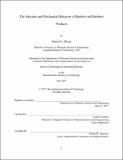The structure and mechanical behavior of bamboo and bamboo products
Author(s)
Dixon, Patrick G. (Patrick Gary)
DownloadFull printable version (129.2Mb)
Other Contributors
Massachusetts Institute of Technology. Department of Materials Science and Engineering.
Advisor
Lorna J. Gibson.
Terms of use
Metadata
Show full item recordAbstract
Bamboo is a unique lignocellulosic material with considerable potential in sustainable construction. Structural bamboo products are analogous to wood products, such as oriented strand board (OSB), but composed primarily of bamboo elements, as opposed to wood elements. Such products could extend the use of bamboo. The mechanical behavior of structural bamboo products in large part depends on that of bamboo tissue. In this thesis, the structure and mechanical properties of dry bamboo tissue are related. Cellular level models are developed and explored, with a focus on density. Density is a practical parameter: it corresponds to weight, and places bamboo in the broader context of cellular solids. Bamboo tissue is made up of parenchyma and vascular bundles, consisting of sclerenchyma fibers and vessels; the structure can be thought of as a fiber reinforced composite. There is a radial gradient in the volume fraction of vascular bundles as well as the fraction of quite solid sclerenchyma fibers within the vascular bundles, increasing from the inside to the outside of the culm wall. Longitudinal flexural properties (modulus of elasticity MOE and modulus of rupture MOR) and compressive strength increase with increasing sclerenchyma fiber volume fraction, indicating the mechanical importance of these fibers. The density also increases with increasing fiber volume fraction. Thus, these longitudinal mechanical properties increase with density. This suggests that in bamboo tissue density reflects the underlying sclerenchyma fiber volume fraction. For moso bamboo (Phyllostachys pubescens), the extrapolated cell wall longitudinal Young's modulus estimate from tests on small flexural specimens, 39.8 GPa, agrees well with the value of 36.6 GPa obtained from a simple cell wall model for the fibers. From mechanical tests of 3D printed models of bamboo parenchyma, an open-cell foam model seems appropriate for bamboo parenchyma. The densification of bamboo increases the longitudinal flexural properties, but natural bamboo at the same density of densified bamboo has higher properties. A multiscale model for wood OSB is adapted for bamboo OSB based on the natural tissue's structure and properties; this model gives a good description of the modulus of elasticity of bamboo OSB made with internode strands.
Description
Thesis: Ph. D., Massachusetts Institute of Technology, Department of Materials Science and Engineering, 2017. This electronic version was submitted by the student author. The certified thesis is available in the Institute Archives and Special Collections. Cataloged from student-submitted PDF version of thesis. Includes bibliographical references (pages 199-215).
Date issued
2017Department
Massachusetts Institute of Technology. Department of Materials Science and EngineeringPublisher
Massachusetts Institute of Technology
Keywords
Materials Science and Engineering.